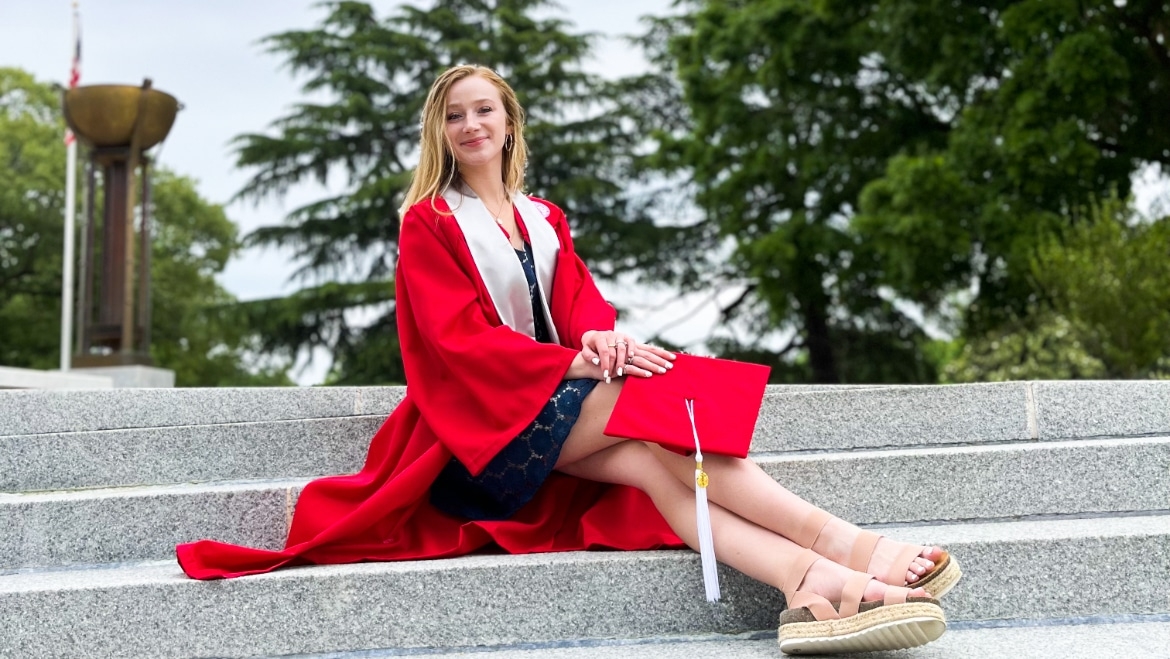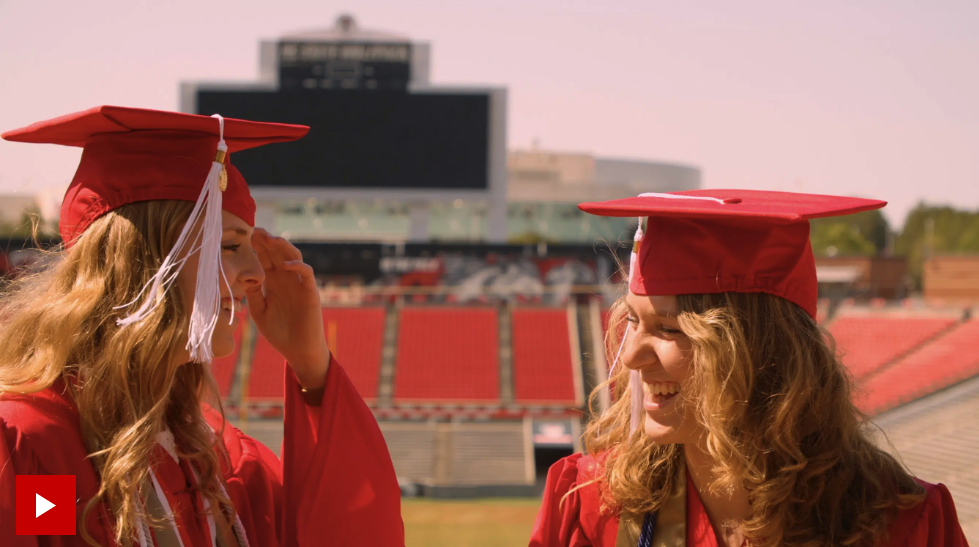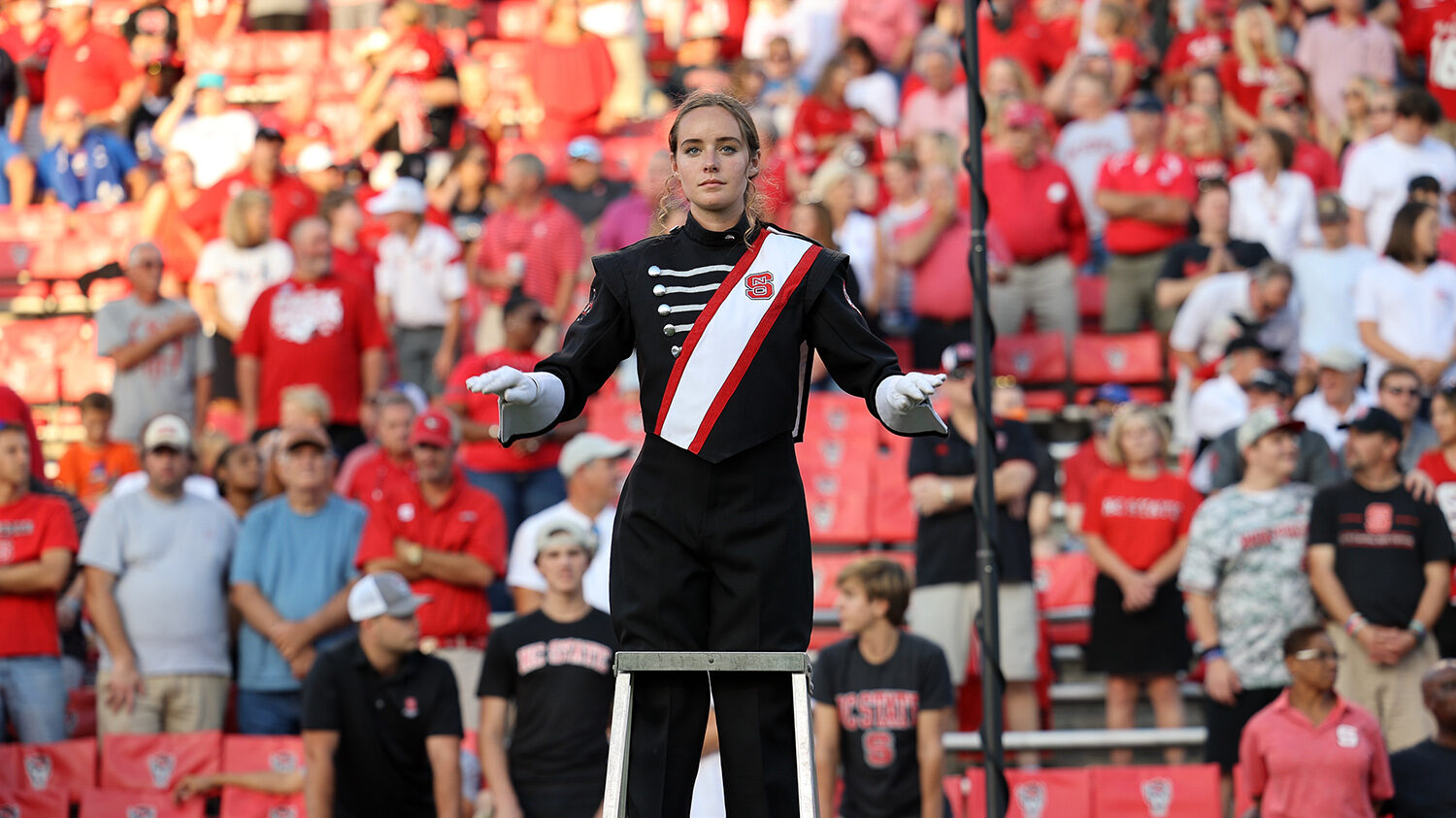Whistlin’ their own tunes
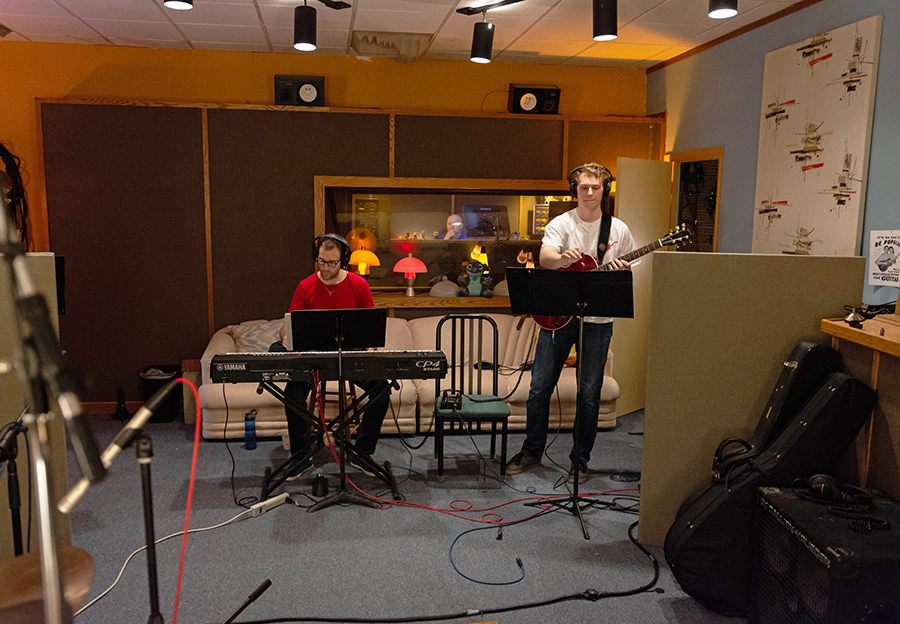
The students in the NC State Jazz Combo went from strangers to bandmates to family. Now they’re releasing an album of mostly original songs and reflecting on their time together doing what they love.
It’s a science and an art, figuring out where each student-musician’s strengths will best fit in order for them and their ensembles to thrive. In the case of the NC State jazz program, which is home to two big bands—Jazz Ensembles I and II—and four smaller combos, the makeup of those ensembles is determined by Director of Jazz Studies Wes Parker. He uses the audition process to assess each student’s experience and abilities and pair them with peers at a similar level. Through their years at NC State, some students work their way up the ranks to either the top big band or the top combo—known as the NC State Jazz Combo—or both.
In the spring of 2018, the combo included Carter Harris on tenor saxophone, Josh Beerel on alto saxophone, Chris Suggs on trumpet, Steven Ray on guitar, Dawud Ghazaleh on bass, Alex Hornaday on drums and Alex Mangot on piano, many of whom had played together for several years by that point.
They were pushing each other and growing together as musicians, and it reached a point where Parker realized he had something special that he wanted to preserve. “This is a once-in-a-lifetime group of students that are incredibly self-motivated, every single one of them,” said Parker. “So I thought [recording an album] would be a good opportunity to archive what they do and what we do in the jazz program, as well as a reward to them for all their hard work because it’s something that they’re going to have for the rest of their lives.”
The strength of the Pack
When Parker joined the Department of Music to direct the jazz program in 2006, he knew he wanted to establish a culture of collaboration and camaraderie in his ensembles which wasn’t going to happen overnight. Over time, the students in the top combo began to embody that culture as they spent more and more time together.
“That kind of attitude and brotherhood or sisterhood, or whatever you want to call it, is the core of a healthy program,” said Parker. “Where I’m having to kick them out of the room like, ‘Guys, go. Go home.’ I would end rehearsals and they’d be jamming for 20 to 30 minutes working on tunes. I couldn’t get them to stop playing sometimes. Establishing that kind of a culture is hard to do. It’s taken us some time to get it to that point.”
[pullquote cite=”Dawud Ghazaleh” color=”bioindigo” align=”alignleft”]You really connect to somebody on a special level whenever you play music with them. All the playing is wonderful, but it’s really about the people in the end.[/pullquote]
It can be difficult to establish consistency with students rotating through on a four-year cycle. The combo had the advantage of having several students who stayed at NC State for graduate school, extending the time they had to build both interpersonal and musical bonds.
Several of the students in the combo have also participated in the big bands, gaining experience that strengthened their skills and prepared them for a smaller combo where each individual musician carries more weight on their shoulders. “There’s no room to hide,” said junior mechanical engineering major and bassist Ghazaleh. “Whenever you’re playing in a small group setting everybody has to play at their top and everybody has to be able to really fill their role. So in a big group maybe you have a bunch of different percussion instruments that can fill different roles but in a small group setting it’s only one drummer. And I’ve always really liked that, where it’s like everybody has their spot.”
For Suggs, a senior mechanical engineering major and trumpet performance minor, the combo provided a different experience from other larger ensembles. “It’s a lot closer knit group than the big band,” he said. “I think with the larger ensembles you get to know the people in your section really well. But aside from that you don’t really get a chance to talk to anybody else outside of rehearsals. So it’s nice to be in a smaller group where you can actually get to know the people that you’re playing with.”
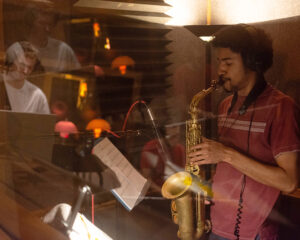
Ghazaleh, who was the newest member of the combo last spring, agrees. “You really connect to somebody on a special level whenever you play music with them,” he said. “Especially with jazz in this setting, it’s very personal. That sort of connection is really strong. All the playing is wonderful, but it’s really about the people in the end.”
From a musical standpoint, the combo allowed the students to form non-competitive and non-judgmental relationships that challenged each of them to improve and supported their growth. Over time, they also learned to anticipate their bandmates’ moves and formed a silent language that allowed them to have a musical conversation rather than a spoken one.
They also support each other outside of rehearsal, such as when the combo performed with music minors Suggs and Hornaday on their final recital last November.
“It was nice to have the whole group on [my recital] with me, especially doing it with Alex,” said Suggs. “Being a part of a group like that—any time you get to play together and produce a final product is really fun.”
For Parker, seeing how tight-knit the combo had become was a bit of a double-edged sword. On the one hand, he had achieved the type of culture he was hoping to build, and on the other he knew it meant that eventually those students would graduate and someone would have to be ready to step into their shoes.
“My dream and my goal when I came here was to have a core group of people that is that dedicated, that into it, and that willing to do everything they can to be better,” said Parker. “And we have that now. And I know I have people that are going to step up. I’m confident of that.”
The nature of the beast
One thing that set this group of student-musicians apart was their affinity for writing and arranging original music for the combo. Harris, Mangot, Ray and Suggs all wrote music that was performed publicly by the combo in one iteration or another with Harris being the most prolific composer and arranger in the group. In total, he had a hand in composing or arranging nine of the 11 tracks on the upcoming album.
“Over the past seven or eight years, Carter [Harris] has become much like Wayne Shorter was to the mid-60s Miles Davis quintets,” said Parker. “He’s become the default arranger and composer. More than half of what we recorded was written by him. And several of the originals written by members of the band, he would take and arrange and write out the different parts. Like the tune that I wrote, he arranged that. He’s got a real talent for it.”
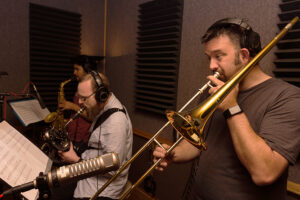
Harris, who completed his Ph.D. in electrical engineering this year, started in Jazz Ensemble II and was in a combo taught by Jason Foureman during his freshman year in 2009. He quickly moved up to Jazz Ensemble I and the NC State Jazz Combo during his sophomore year, where he stayed happily for a decade of undergrad and graduate school.
At the time, that move was a huge leap for Harris who felt like he was in way over his head. “They would call songs that were very difficult, they would play them very fast and I just had no clue what was going on,” he said. “But it was a good environment for me. I could sort of see the trajectory from where I was to what was possible, so that motivated me to work really hard.”
Parker said Harris borrowed and devoured his Mike Tomaro arranging book and jumped right into arranging music for Jazz Ensemble I and then for the combo. Harris enjoyed the different challenges presented by arranging music for both types of ensemble, incorporating improvisation opportunities and building the arrangements around the players, rather than vice versa.
“Trying to fit every band with some sort of statistical model of they’re probably this good and not that good, you’ll get decent results,” said Harris. “But if you’re thinking about ‘Josh sounds great when we do this,’ you can bake that into the arrangement. Hearing Josh play on the song that I wrote, and he played on it better than I ever did, was humbling and also really exciting because if you can make something that brings that out of other players, it’s a pretty great feeling.”
The group enjoyed collaborating on the pieces their bandmates had written so much that when it was time to choose music for the album, Parker said it was natural that they’d settle on their own originals for the majority of the tracks. “Creatively, Carter [Harris] was kind of the driving force for a long time. So choosing the tunes was simple because he has so many great tunes that he’s written. And then Steven [Ray] wrote a tune that was just incredible that we wanted to put on there, and Alex [Mangot], the piano player, wrote two tunes, and I did one. We wanted it to be eclectic and if you listen to the album, it’s really eclectic. It’s got a wide variety of styles and it’s—in my opinion—a well put together product.”
Permanent record
When it came time to record the album, Parker booked one weekend of studio time in May 2018 at Osceola Studios in Raleigh with audio engineer Dick Hodgin.
Suggs was doing his engineering co-op at the time, and was only able to join the group for one track. The rest of the group recorded the remaining tunes with Parker, who plays trombone on all but one track, and Foureman, who plays bass on one track. Parker saw the recording as the ultimate capstone experience for the students in the combo and said that they packed about four years of experience into 16 hours of studio time.
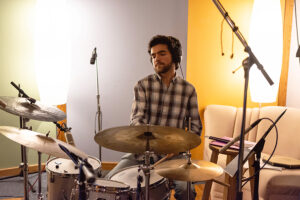
“They learned so much about consistency,” Parker said. “I insisted that we record it live. The engineer wanted to record the rhythm section alone and then record the horns separately. I wanted it to be everybody at the same time because there’s no other way to get that communication and organic kind of process. I could go on for hours about how much they learned.”
For most of the students it was their first time in a recording studio. They worked hard in the months leading up to it to select their songs and polish them in preparation for the two days in studio. Once they actually got in there, all of the groundwork they had laid made the days run very smoothly. The process challenged them in terms of communication, execution and musical expression, and Parker said they all stepped up to that challenge. For the students, the experience was one they won’t forget.
“There’s magic in the air in the studio,” said Ghazaleh. “Being in that sort of environment where everything is very professional—you’ve got the sound engineer there with you walking through all the tunes—it’s very surreal. Something clicks whenever you’re in that sort of environment. It was really special and it made me want to play all day long and never leave.”
Parker sees the finished product less in terms of his own role as their teacher and more in terms of the drive and abilities of his students. “I sometimes look at myself as less of a teacher, more of a traffic director, traffic cop or facilitator, because I firmly believe you should teach people to fish more than you give them fish,” he said. “Sometimes they fail, sometimes they succeed, sometimes they completely blow my expectations out of the water, and the perfect example of that is the CD. They were the ones that did the bulk of the work. I just facilitated, made sure we had a studio, made sure we had equipment there, made sure we had coffee. And I played trombone on some of it. So yeah, it’s their thing, their success.”
Loss
The group’s achievement took on an unexpected weight due to the tragic loss of guitarist Steven Ray in the summer of 2018, shortly following the recording of the album. His death shook them deeply and left them grappling with questions they’ll never be able to answer.
Parker describes Ray as the “quiet fire” of the group; everything focused on him and went through him. “So the rhythm section, when they would do something it was like this hive mind. They’d say, ‘Well, what does Steven think about this? Steven looks like he’s cool with it. Alright, here’s what Steven would do here.’ It was a sight to behold.
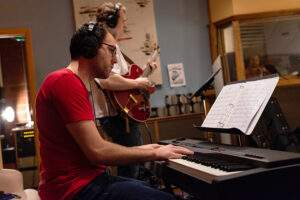
“I often talk about the mid-1960’s Miles Davis rhythm section,” Parker added. “It had Tony Williams and Ron Carter and Herbie Hancock in it. And that’s what I want my rhythm sections to be like. They didn’t talk. They wouldn’t even talk about what tune they were going to play. Herbie Hancock would just start playing and they would recognize it, and they wouldn’t say we’re going to do this tempo, we’re going to do this time signature, they’d just play. And then Miles Davis and Wayne Shorter would get up and play over the top of that. That’s the connectedness that I want my rhythm sections to strive for, and with that rhythm section it just clicked. It was amazing. When they played with Steven it was a force.”
Harris described Ray as both one of his best friends and one of the biggest factors in the success of the combo. “Steven was sort of the quiet energy that drove everybody forward, both in terms of the music and how he could perform and really just get like the last few drops of good stuff out of every musical moment, but also his demeanor and the way he could get along with everybody so effortlessly was really crucial to everyone having a good time,” he said. “And if you’re not having a good time then everything suffers in the band. So being able to listen back to his solos, listen to the song he wrote on the album, listen to how his playing took songs that I wrote to levels that I didn’t think were possible, and just really having all of those parts of him saved on the record has been really hard but also incredibly valuable to me.
“What does it mean to have it? It’s really hard to say because just in a vacuum if I had a record of all the songs I had written and copies of all the best performances of them and just could have that for myself, that would be an amazing thing to have,” Harris added. “But it was very hard to listen to the album for a long time and now it’s much more often a source of joy and happy remembrance than other feelings. But it will always be a very complicated thing for me. It could have happened a lot of different ways and we could have recorded it a couple of months later and he wouldn’t have been there for it. So we’re super lucky to have done that with him. We were lucky to have him in the band for five years.”
They named the album Whistlin’ after the song written by Ray. His impact on his bandmates and the music they created is profound. Now that a year has passed since the recording and Ray’s passing, Parker is able to separate his grief from the significance of the combo’s achievement while acknowledging that the two are inextricably linked.
“It would have been monumental without that happening, but with that it just changes the whole thing,” said Parker. “I’m still not over it obviously, I don’t think I ever will be. I don’t think you ever completely get over these things. The one thing that I constantly go back to is, I’m just incredibly grateful that we did [record the album]. Because had we not, we wouldn’t have this great example of how amazing he was as a musician. This project was already a huge deal, but it’s a lot more personal and meaningful for us now.”
Lasting impact
As proud as Parker is of the album, he can also be proud of the impact that he and his program have had on his students. As several members of the combo prepare to graduate and move on this year, new members are stepping into the gaps. These new students now have the opportunity to shape the combo based on the strengths they bring to the table and the relationships they’ll form.
For Harris, the jazz program was a source of strength and personal growth. “The opportunities I’ve had in the jazz program because of Wes [Parker] have been probably the primary reason I’ve been able to tough it out through my Ph.D.,” he said. “It’s one of the few things that has consistently kept me attached to and invested in school even when things have been incredibly hard. It’s been a venue for me to grow emotionally, musically, in lots of different ways. It’s been a place that I’ve been able to take on new responsibilities and learn what I’m good at and what I need to work on more. That’s not just musicianship but interacting with people, being a better leader, being a better mentor, being a better student.”
The times when they could come together to play music and forget about the stress of school were meaningful for Ghazaleh too. “Engineering gets very stressful and very overwhelming very quick, and so every week whenever I get to set aside that time and forget about everything and just play some music, it really is like a release for me,” he said. “So it’s been huge. I wouldn’t be able to do what I’m doing at school unless I had that release through music.
“A lot of people don’t get this opportunity,” he added. “I don’t know if I can stress enough how cool this opportunity has been and how special this opportunity has been because it’s not very often you get a good group of people who really play well together and who are able to just make it work within one year. It’s pretty special.” ♪
[callout bodyfontface=”glypha” headingicon=”noicon” textalign=”textcenter” url=”https://go.ncsu.edu/whistlin” target=”true” type=”img” bgcolor=”wolfpackred” img=”14285″ mediaposition=”left” margin=”normal”]Whistlin’ will be released this Christmas and you can sign up to be notified when pre-orders begin at go.ncsu.edu/whistlin.[/callout]

Correction: This article was first published in the Fall 2019 edition of Wolf Tones, our alumni magazine. This version corrects a printing error that omitted portions of the text.
- Categories:
